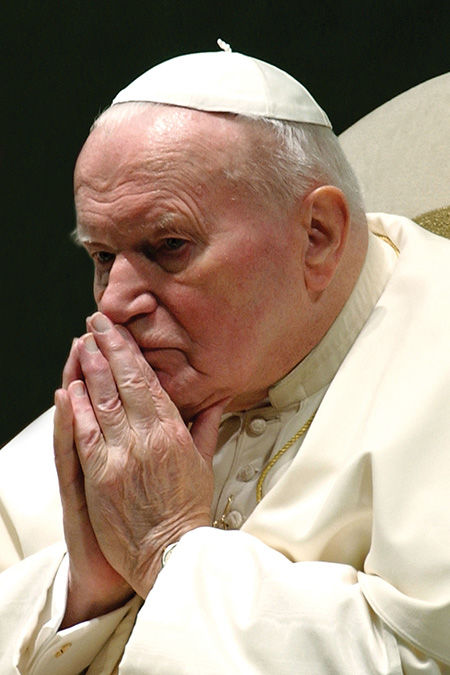The door opened off a corridor and there was Pope John Paul II, sitting next to a window, reading his worn-out breviary. With a rigid neck, he had to turn his whole body standing up. And when Dr. Vincent Fortanasce put out his hand to kiss his ring, he shook it with both of his hands, smiling.
After a half-hour medical exam with questions to the Holy Father about his growing symptoms, it became “very, very apparent” to the California neurologist, whose specialty is nerve degenerative diseases, that the pope had Parkinson’s disease. He was also suffering cervical arthritis so badly that his stooped neck was nearly locked in one position. The physician figured it was probably from bending over reading the Litany of the Hours in that breviary every day.
“But when I talked to him, he asked me why I was there in Rome,” Fortanasce, who shares a medical specialty practice in Arcadia, recalled. “And I told him I was there to work a few weeks at a clinic run by the Order of Malta. ‘But the real reason that I’m here is because I fight for life issues.’”
The 70-year-old bioethicist, psychiatrist and board-certified neurologist told the pope how he had been involved in defeating California’s so-called “aid-in-dying” euthanasia proposition in 1992. Now eight years later, his big concern was with biotechnology and the burgeoning stem cell issue, using human embryo cells and cloning to do research. But his medical colleagues and others weren’t listening, which made him feel both utterly frustrated and depressed.
Pope John Paul II shook his head as much as he could, observing in Italian that he thought the matter boiled down to eugenics. “He looked at me and he said, ‘Remember one thing. Give without expecting to get anything back,’” Fortanasce recently told The Tidings.
“And then he said, ‘Preach without expecting people to necessarily listen.’ And then he followed up and said, ‘The greatest prophets were those who were persecuted because they said what people did not want to hear.’”
The pontiff continued in English, speaking in a slow but thoughtful cadence: “To be human, we can expect suffering. And God gave us that suffering for a purpose. Suffering and hardship brings forth character in man. It brings out the best in man’s humanity. It makes an empathetic person. It makes us realistic and less self-centered and helps us because of our experience to want to help others.
“Those who never suffered cannot understand human suffering and cannot understand the human person. Nor can they really understand the suffering of the poor or the ill or the old. And they especially cannot understand the place of the unborn. So the unborn are without a voice.”
Fortanasce recalls the pope stressing there wasn’t — or shouldn’t be — any conflict between science and the laws of man. In fact, they work together, he pointed out. But humans must realize their limitations and live within them. Because some new scientific advancement is possible, doesn’t mean it has to be carried out.
“What he said to me just completely changed my life in that it reinforced what I had believed,” said the Renaissance man, who was a star athlete at Seton Hall University and Yale Medical School and has coauthored more than half-a-dozen books. “I had started to become very, very despondent, you know, because it was so apparent that no matter who I would talk to about these life issues would really listen. They would smile at me and that was about it. They wouldn’t believe that we were actually going to be making clones and we were going to use human embryos and we were going to be experimenting on them.”
He also remembers the “tremendous pain” in the pope’s face during the physical examination. At one point, he simply referred to his failing body the same way St. Francis supposedly did as “the poor one.”
But there were lots of little grins, too.
“He seemed to give me those smiles when I was telling him how severely depressed I was,” the physician confided. “Here I am going to treat him, and he’s treating me, noticing that I am suffering. He’s paying attention to my suffering, and this poor man has cervical radiculopathy [nerve damage], severe Parkinsonism, and he’s worried about me because I’m depressed that nobody will listen to me.”
Fortanasce broke up laughing at the memory, still fresh 13 1/2 years later.
“You could see the small smiles on either side of his face looking up at me,” he said. “And what I was getting when he was smiling was, ‘Hey, join the club. Nobody listens to me, either.’”
After a pontificate lasting 25 years, Pope John Paul II died on April 2, 2005, at the age of 84. The first of two miracles needed for canonization happened to Sister Marie Simon-Pierre in Paris. Upon praying to the popular pontiff, her Parkinson’s disease miraculously disappeared in 2005.

